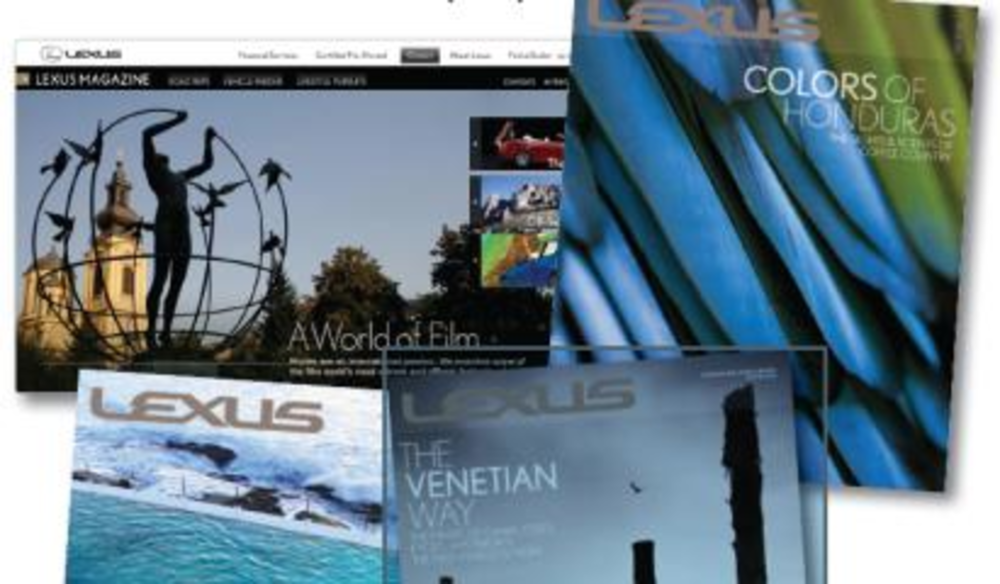If you went out and spent $70,000 on a single good, wouldn’t you want some special attention and recognition? Luxury car company Lexus has long known that its customers appreciate engagement, as evidenced by the 2002 launch of a global custom publishing campaign. But the evolution of Lexus’ brand marketing strategy — which has grown to include a Web site, MSN portal, e-mail newsletters, video stories, travelogues for TiVo, streaming video for mobile phones, and serialized fiction, all full of custom content designed for Lexus buyers — is a perfect illustration of the evolution of custom publishing as a discipline.
“Twenty years ago there was this notion that custom publications were a nice thing to have, but now we can identify that they are really powerful marketing tools that not only increase brand resonance within the audience but can move consumers to action,” says Simon Kelly, COO of Story Worldwide, which works with Lexus on its custom publishing efforts.
More than 1.1 million current customers receive issues of Lexus, a quarterly magazine, and more than 80% of the Lexus owner base says they feel more valued as a result of receiving the publication, Kelly reports. Fifteen percent report actually having bought a vehicle as a result of reading Lexus.
But it’s not just the magazine that is pushing the Lexus brand — it’s the breadth of custom content that Lexus customers receive.
“Ultimately, marketing is publishing,” Kelly points out. “Marketing in the post-advertising age, whether on Facebook or Twitter or mobile, is all about understanding a group of people and how best to engage and interact with them using content.”
On a basic level, custom publishing works like many loyalty-building efforts: It offers something targeted to engage customers with the brand, creating value for the customers, drawing them further in and enhancing their feelings of goodwill toward a brand.
“There’s a real opportunity to measure ROI,” says Craig Waller, president of Pace Airline Media and CMO of Pace Communications. “But there is also a brand dimension, which expands the relationship with the customer.”
In the current economy, customer retention has emerged from the long shadow of acquisition marketing, and brands are looking for ways to communicate with tried and true customers on a personal level.
“The goal is a much higher level of trust, which is really key in this environment,” says Valerie Valente, SVP and publishing director for Rodale Custom Publishing. “Companies that can bring consumers along the trust continuum have been very successful, and that’s what this discipline really brings to bear.”
Engaging customers in today’s competitive environment demands that a brand precisely meet their needs. These days, that means being available anywhere, any time, on whatever media the consumer prefers.
Though custom publishing has, like consumer publishing, explored different media for some time, it’s only been in the past few years that the other channels have truly started holding their own. Now, custom Web sites, newsletters, blogs, widgets and even content-driven mobile applications can be created by the more advanced custom publishing companies.
“The smart custom publishers realize that they are really branded content providers,” says Michael Winkleman, chairman of the Custom Publishing Council (CPC) and president and CCO of Leverage Media. “What matters is informational, valuable content.”
Rodale’s custom publishing business is split evenly between digital and analog formats, and nearly all of the company’s projects cover multiple channels. The growing social and online aspect of custom publishing increases the trust and loyalty between consumers and custom publishing brands, Valente says.
“Retention or loyalty efforts are enhanced by building community, and you build community online,” points out Marcie Avram, associate publisher of marketing and business development at Rodale Custom Publishing.
The increase in channels available to custom publishers and their clients also calls for more work on the publisher’s end, particularly in the realm of database marketing and segmentation. No longer is a single magazine printed out and mailed to all existing clients. Now, different segments of a consumer base receive different messages, often created in different media.
“Segmentation, I think, is a major trend, which fits with direct marketing very well,” explains Waller. “The growth is in focusing on parts of the database where you can apply different models and different content approaches to different segments. What started off as talking to customers through custom content has become much more sophisticated and targeted.”
He adds that segmentation, though it takes an investment of time and money up front, pays off in the long run, by creating more efficient and effective marketing programs.
Sophisticated measuring techniques also play a big role in custom publishing’s growing popularity with CMOs and marketers. Because the pieces are so targeted and because their distribution is highly controlled, it’s easy for marketers to gauge their success by measuring such metrics as ROI, churn rates and loyalty ratings. In today’s tight economy, proving that a marketing piece can deliver on its promise is key for any company selling marketing services, and custom publishers stress this characteristic of their offerings.
“The reason custom publishing is growing is because it’s being measured, and it’s effective,” Waller explains.
However, no matter how many iterations it takes on or how many tools publishers acquire, content remains the key to successful custom publishing. Unless a piece truly speaks to consumers, creating an emotional connection with a brand, it’s not worthwhile — and it’s not really custom publishing.
“I feel like our business has really arrived as a critical discipline in the marketing mix,” says Valente. “The editorial is really about the top-down and bottom-up coming together. The discipline brings together company information with what that end reader cares about.”








